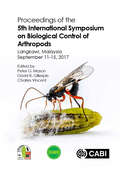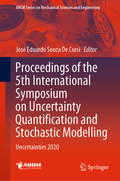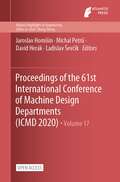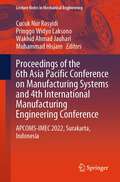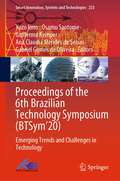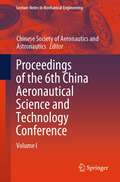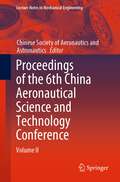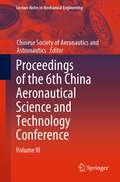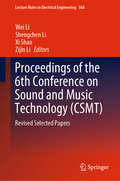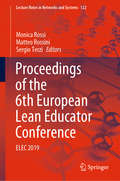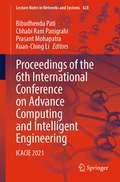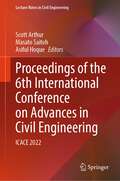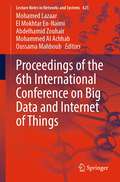- Table View
- List View
Proceedings of the 5th International Symposium on Asphalt Pavements & Environment (Lecture Notes in Civil Engineering #48)
by Manfred N. Partl Gabriele Tebaldi Marco PasettoThis volume highlights the latest advances, innovations, and applications in the field of asphalt pavement technology, as presented by leading international researchers and engineers at the 5th International Symposium on Asphalt Pavements & Environment (ISAP 2019 APE Symposium), held in Padua, Italy on September 11-13, 2019. It covers a diverse range of topics concerning materials and technologies for asphalt pavements, designed for sustainability and environmental compatibility: sustainable pavement materials, marginal materials for asphalt pavements, pavement structures, testing methods and performance, maintenance and management methods, urban heat island mitigation, energy harvesting, and Life Cycle Assessment. The contributions, which were selected by means of a rigorous international peer-review process, present a wealth of exciting ideas that will open novel research directions and foster multidisciplinary collaboration among different specialists.
Proceedings of the 5th International Symposium on Biological Control of Arthropods
by Malaysia LangkawiThe 5th International Symposium on Biological Control of Arthropods, held in Langkawi, Malaysia, continues the series of international symposia on the biological control of arthropods organized every four years. The first meeting was in Honolulu, Hawaii, USA in January 2002, followed by the Davos, Switzerland meeting in September 2005, the Christchurch, New Zealand meeting in February 2009, and the Pucón, Chile meeting in March 2013. The goal of these symposia is to create a forum where biological control researchers and practitioners can meet and exchange information, to promote discussions of up-to-date issues affecting biological control, particularly pertaining the use of parasitoids and predators as biological control agents. This includes all approaches to biological control: conservation, augmentation, and importation of natural enemy species for the control of arthropod targets, as well as other transversal issues related to its implementation. Topics covered include: - non-target impacts in biological control as the cornerstone of successful integrated pest management programmes; - regulation and risk assessment methodology; - implementing access and benefit sharing policies; - assessing the impact of biological control programmes for both cost-benefit analyses and determining the socio-economic impact and effect on livelihoods; - understanding the uptake of biological control solutions in low and lower middle income countries to replace the use of highly hazardous pesticides; - the role of native and exotic natural enemies; and - the importance of pre- and post-genetics in biological control.
Proceedings of the 5th International Symposium on Uncertainty Quantification and Stochastic Modelling: Uncertainties 2020 (Lecture Notes in Mechanical Engineering)
by José Eduardo Souza De CursiThis proceedings book discusses state-of-the-art research on uncertainty quantification in mechanical engineering, including statistical data concerning the entries and parameters of a system to produce statistical data on the outputs of the system. It is based on papers presented at Uncertainties 2020, a workshop organized on behalf of the Scientific Committee on Uncertainty in Mechanics (Mécanique et Incertain) of the AFM (French Society of Mechanical Sciences), the Scientific Committee on Stochastic Modeling and Uncertainty Quantification of the ABCM (Brazilian Society of Mechanical Sciences) and the SBMAC (Brazilian Society of Applied Mathematics).
Proceedings of the 5th International Symposium on Water Resource and Environmental Management: Sustainable Development of Water Resource and Environmental Management (Environmental Science and Engineering)
by Haoqing XuThis book is designed to be the introductory work in the new Sustainable Development of Water Resource and Environmental Management Series and provides an in-depth look at sustainable development and management in the water sector across. In the face of current global changes, the availability and quality of water resources are under severe threat. Indeed, in all sectors related to water resources management, sustainable development is important for present and future generations. This book includes selected papers from the 5th International Symposium on Water Resource and Environmental Management (WREM 2022) and consists of themes pertaining to water resource and environmental management. It provides readers with comprehensive information on the principles of sustainable water resources management, as well as recent advances, directions for future research, and policy development for sustainable water resources management. As a reference, it is of interest to students, scientists, engineers, government officials, and water resource managers.
Proceedings of the 61st Conference of Metallurgists, COM 2022
by Metallurgy and Materials Society of CIMThese Proceedings represent the metallurgical engineering and materials science research presented at the 61st Annual Conference of Metallurgists. The collection themed ‘The Pathway to Net-Zero’ presents findings on a wide range of topics including: Processing of Critical Metals Towards Sustainable Circularity: Mining to Materials Deep Decarbonization Pathways for Pyrometallurgical Processes: Opportunities & Challenges Energy and Environmental Materials Light Metals for the Transportation Industry Advances in Materials Manufacturing – Existing and Emerging Materials Electrochemical Degradation of Multi-component Materials
Proceedings of the 61st International Conference of Machine Design Departments (Atlantis Highlights in Engineering #17)
by Michal Petrů Jaroslav Homišin David Herák Ladislav ŠevčíkThis is an open access book.The 61st International Conference of Machine Design Departments is mainly focused on sharing professional experience and discussing new theoretical and practical findings. The objective of the conference is to identify the current situation, exchange experience, establish and strengthen relationships between universities, companies and scientists from the field of Machine Design.
Proceedings of the 62nd Conference of Metallurgists, COM 2023
by Metallurgy and Materials Society of CIMThese Proceedings represent the metallurgical engineering and materials science research presented at the 62nd Annual Conference of Metallurgists (COM 2023), held in Toronto, Canada, from 21 to 24 August 2023. The Annual Conference of Metallurgists is organized by the Metallurgy & Materials Society of the Canadian Institute of Mining, Metallurgy and Petroleum (MetSoc of CIM). The collection themed ‘Climate Change and Sustainability’ presents findings on a wide range of topics, including:Advanced Manufacturing and MaterialsSustainability: Integration for Better OutcomesLight Metals for Transportation and Next Generation VehiclesDerek Kerfoot Memorial Pressure Hydrometallurgy SymposiumLaplante-Laskowski Symposium on Mineral Processing FundamentalsWasmund Memorial Symposium of Sustainability in Pyrometallurgy
Proceedings of the 63rd Conference of Metallurgists, COM 2024
by Metallurgy and Materials Society of CIMThese Proceedings represent the metallurgical engineering and materials science research presented at the 63rd Annual Conference of Metallurgists (COM 2024), held in Halifax, Nova Scotia, Canada, from August 19 to 22, 2024.. The Annual Conference of Metallurgists is organized by the Metallurgy and Materials Society of the Canadian Institute of Mining, Metallurgy and Petroleum (MetSoc of CIM). The collection themed ‘Clean Technologies for a Materials-Intensive Future’ presents findings on a wide range of topics, including: Advanced Manufacturing and Materials VII Arsenic/Minor Element Controls in Metallurgical Plants Corrosion and Environmental Degradation of Materials Electrometallurgy for a Net Zero Economy Extractive Metallurgy from Conception to Operation: Experimentation , Simulation, Pilot and Ramp-up 25th International Biohydrometallurgy Symposium (IBS 2024) Joe Ferron Memorial Symposium – Processing of Critical Materials Light Metals for Transportation: Marine, Aviation, and Ground Applications WALSIM X: Water, Air, Land Sustainability Issues in Mining and Metal Extraction
Proceedings of the 6th Asia Pacific Conference on Manufacturing Systems and 4th International Manufacturing Engineering Conference: APCOMS-IMEC 2022, Surakarta, Indonesia (Lecture Notes in Mechanical Engineering)
by Cucuk Nur Rosyidi Pringgo Widyo Laksono Wakhid Ahmad Jauhari Muhammad HisjamThis book presents the proceedings of the 4th Asia Pacific Conference on Manufacturing Systems and International Manufacturing Engineering Conference (APCOMS-IMEC 2022), held in Surakarta, Indonesia, on 27 October 2022. The book presented selected papers covering scientific research in the field of manufacturing engineering, with focuses on industrial engineering, materials, and processes. The book appeals to researchers, academics, scientists, students, engineers, and practitioners who are interested in the latest developments and applications related to manufacturing engineering.
Proceedings of the 6th Brazilian Technology Symposium: Emerging Trends and Challenges in Technology (Smart Innovation, Systems and Technologies #233)
by Yuzo Iano Osamu Saotome Guillermo Kemper Ana Claudia Mendes de Seixas Gabriel Gomes de OliveiraThis book presents the Proceedings of The 6th Brazilian Technology Symposium (BTSym'20). The book discusses the current technological issues on Systems Engineering, Mathematics and Physical Sciences, such as the Transmission Line, Protein-Modified Mortars, Electromagnetic Properties, Clock Domains, Chebyshev Polynomials, Satellite Control Systems, Hough Transform, Watershed Transform, Blood Smear Images, Toxoplasma Gondi, Operation System Developments, MIMO Systems, Geothermal-Photovoltaic Energy Systems, Mineral Flotation Application, CMOS Techniques, Frameworks Developments, Physiological Parameters Applications, Brain–Computer Interface, Artificial Neural Networks, Computational Vision, Security Applications, FPGA Applications, IoT, Residential Automation, Data Acquisition, Industry 4.0, Cyber-Physical Systems, Digital Image Processing, Patters Recognition, Machine Learning, Photocatalytic Process, Physical–Chemical Analysis, Smoothing Filters, Frequency Synthesizers, Voltage-Controlled Ring Oscillator, Difference Amplifier, Photocatalysis, Photodegradation, current technological issues on Human, Smart and Sustainable Future of Cities, such as the Digital Transformation, Data Science, Hydrothermal Dispatch, Project Knowledge Transfer, Immunization Programs, Efficiency and Predictive Methods, PMBOK Applications, Logistics Process, IoT, Data Acquisition, Industry 4.0, Cyber-Physical Systems, Fingerspelling Recognition, Cognitive Ergonomics, Ecosystem Services, Environmental, Ecosystem Services Valuation, Solid Waste and University Extension.
Proceedings of the 6th China Aeronautical Science and Technology Conference: Volume I (Lecture Notes in Mechanical Engineering)
by Chinese Society of Aeronautics and AstronauticsThis book contains the original peer-reviewed research papers presented at the 6th China Aeronautical Science and Technology Conference held in Wuzhen, Zhejiang Province, China, in September 2023. Topics covered include but are not limited to Navigation/Guidance and Control Technology, Aircraft Design and Overall Optimisation of Key Technologies, Aviation Testing Technology, Airborne Systems/Electromechanical Technology, Structural Design, Aerodynamics and Flight Mechanics, Advanced Aviation Materials and Manufacturing Technology, Advanced Aviation Propulsion Technology, and Civil Aviation Transportation. The papers presented here share the latest findings in aviation science and technology, making the book a valuable resource for researchers, engineers and students in related fields.
Proceedings of the 6th China Aeronautical Science and Technology Conference: Volume II (Lecture Notes in Mechanical Engineering)
by Chinese Society of Aeronautics and AstronauticsThis book contains the original peer-reviewed research papers presented at the 6th China Aeronautical Science and Technology Conference held in Wuzhen, Zhejiang Province, China, in September 2023. Topics covered include but are not limited to Navigation/Guidance and Control Technology, Aircraft Design and Overall Optimisation of Key Technologies, Aviation Testing Technology, Airborne Systems/Electromechanical Technology, Structural Design, Aerodynamics and Flight Mechanics, Advanced Aviation Materials and Manufacturing Technology, Advanced Aviation Propulsion Technology, and Civil Aviation Transportation. The papers presented here share the latest findings in aviation science and technology, making the book a valuable resource for researchers, engineers and students in related fields.
Proceedings of the 6th China Aeronautical Science and Technology Conference: Volume III (Lecture Notes in Mechanical Engineering)
by Chinese Society of Aeronautics and AstronauticsThis book contains the original peer-reviewed research papers presented at the 6th China Aeronautical Science and Technology Conference held in Wuzhen, Zhejiang Province, China, in September 2023. Topics covered include but are not limited to Navigation/Guidance and Control Technology, Aircraft Design and Overall Optimisation of Key Technologies, Aviation Testing Technology, Airborne Systems/Electromechanical Technology, Structural Design, Aerodynamics and Flight Mechanics, Advanced Aviation Materials and Manufacturing Technology, Advanced Aviation Propulsion Technology, and Civil Aviation Transportation. The papers presented here share the latest findings in aviation science and technology, making the book a valuable resource for researchers, engineers and students in related fields.
Proceedings of the 6th China High Resolution Earth Observation Conference (Lecture Notes in Electrical Engineering #657)
by Liheng Wang Yirong Wu Jianya GongThis book gathers the proceedings of the 6th China High Resolution Earth Observation Conference (CHREOC). Since its inception, the conference series has become an influential academic event in the earth detection area and attracted more and more top experts and industry practitioners in related fields. CHREOC chiefly focuses on popular topics including military-civilian integration, the One Belt and One Road initiative, and the transformation of scientific research achievements, while also discussing new ideas, new technologies, new methods, and new developments. The CHREOC conferences have effectively promoted high-level institutional mechanisms, technological innovation, and industrial upgrading in the high-resolution earth observation area, and sparked new interest in the major national-sponsored project CHREOS.The majority of the contributing authors are researchers and experts participating in the CHREOS project. The papers highlight new findings, technical innovations, and research directions in the field of high-resolution earth observation. All articles have undergone several rounds of expert review and reflect cutting-edge advances. Accordingly, the proceedings offer an informative and valuable resource for both academic research and engineering practice.
Proceedings of the 6th Conference on Sound and Music Technology: Revised Selected Papers (Lecture Notes in Electrical Engineering #568)
by Wei Li Shengchen Li Xi Shao Zijin LiThis book discusses the use of advanced techniques to produce and understand music in a digital way. It gathers the first-ever English-language proceedings of the Conference on Sound and Music Technology (CSMT), which was held in Xiamen, China in 2018. As a leading event, the CSMT reflects the latest advances in acoustic and music technologies in China. Sound and technology are more closely linked than most people assume. For example, signal-processing methods form the basis of music feature extraction, while mathematics provides an objective means of representing current musicological theories and discovering new ones. Moreover, machine-learning methods include popular deep learning algorithms and are used in a broad range of contexts, from discovering patterns in music features to producing music. As these proceedings demonstrate, modern technologies not only offer new ways to create music, but can also help people perceive sound in innovative new ways.
Proceedings of the 6th European Lean Educator Conference: ELEC 2019 (Lecture Notes in Networks and Systems #122)
by Sergio Terzi Monica Rossi Matteo RossiniThis book gathers selected peer-reviewed papers presented at the 6th European Lean Educator Conference (ELEC), held in Milan, Italy, on November 11-13, 2019. The conference topics include the following: lean trainings in university and industry collaborations; lean product and process development; lean and people empowerment; emerging contexts for lean applications; measuring lean performance; lean, green and circular; continuous improvement initiatives; lean thinking in practice; organizational culture in lean journeys; and innovative training approaches to teaching lean management. The contributions explore the latest academic and industrial findings on and advances in lean education, and identify innovative methods that allow lean thinking benefits to be achieved in practice. As such, the book presents the outcomes of a fruitful exchange between academia and industry designed to help train the next generation of lean educators.
Proceedings of the 6th FIRST 2022 International Conference (Atlantis Highlights in Engineering #14)
by Wahyu Caesarendra Nyayu Latifah Husni Martha Aznury Leni Novianti Deris StiawanThis is an open access book.The 6th FIRST 2022 International Conference offers the researchers in academics, industries, and governments, a conference, for exchanging, sharing, following up, and discussing the results of the latest researches, industry’s needs, and government regulatory policies. The 6th FIRST 2022 International Conference facilitates the participants from all over the world to meet face to face to open chances in establishing connections and collaboration among them.
Proceedings of the 6th International Asia Conference on Industrial Engineering and Management Innovation
by Ershi QiThe 6th International Asia Conference on Industrial Engineering and Management Innovation is sponsored by the Chinese Industrial Engineering Institution and organized by Tianjin University. The conference aims to share and disseminate information on the most recent and relevant researches, theories and practices in industrial and system engineering to promote their development and application in university and enterprises.
Proceedings of the 6th International Asia Conference on Industrial Engineering and Management Innovation
by Ershi QiThe 6th International Asia Conference on Industrial Engineering and Management Innovation is sponsored by the Chinese Industrial Engineering Institution and organized by Tianjin University. The conference aims to share and disseminate information on the most recent and relevant researches, theories and practices in industrial and system engineering to promote their development and application in university and enterprises.
Proceedings of the 6th International Conference and Exhibition on Sustainable Energy and Advanced Materials: ICE-SEAM 2019, 16—17 October 2019, Surakarta, Indonesia (Lecture Notes in Mechanical Engineering)
by Ubaidillah Sabino Fitrian Imaduddin Aditya Rio PrabowoThis book gathers the proceedings of the 6th International Conference and Exhibition on Sustainable Energy and Advanced Materials (ICE-SEAM 2019), held on 16–17 October 2019 in Surakarta, Indonesia. It focuses on two relatively broad areas – advanced materials and sustainable energy – and a diverse range of subtopics: Advanced Materials and Related Technologies: Liquid Crystals, Semiconductors, Superconductors, Optics, Lasers, Sensors, Mesoporous Materials, Nanomaterials, Smart Ferrous Materials, Amorphous Materials, Crystalline Materials, Biomaterials, Metamaterials, Composites, Polymers, Design, Analysis, Development, Manufacturing, Processing and Testing for Advanced Materials. Sustainable Energy and Related Technologies: Energy Management, Storage, Conservation, Industrial Energy Efficiency, Energy-Efficient Buildings, Energy-Efficient Traffic Systems, Energy Distribution, Energy Modeling, Hybrid and Integrated Energy Systems, Fossil Energy, Nuclear Energy, Bioenergy, Biogas, Biomass Geothermal Power, Non-Fossil Energies, Wind Energy, Hydropower, Solar Photovoltaic, Fuel Cells, Electrification, and Electrical Power Systems and Controls.
Proceedings of the 6th International Conference on Advance Computing and Intelligent Engineering: ICACIE 2021 (Lecture Notes in Networks and Systems #428)
by Kuan-Ching Li Bibudhendu Pati Chhabi Rani Panigrahi Prasant MohapatraThis book gathers high-quality research papers presented at the 6th International Conference on Advanced Computing and Intelligent Engineering (ICACIE 2021) organized by Bhubaneswar Institute of Technology, Bhubaneswar, Odisha, India, during December 23–24, 2021. It includes sections describing technical advances and the latest research in the fields of computing and intelligent engineering. Intended for graduate students and researchers working in the disciplines of computer science and engineering, the proceedings also appeal to researchers in the field of electronics, as they cover hardware technologies and future communication technologies.
Proceedings of the 6th International Conference on Advanced High Strength Steel and Press Hardening (Atlantis Highlights in Materials Science and Technology #2)
by Yisheng Zhang Mingtu MaThis is an open access book.The scope of papers is as follows (including but not limited to): Material and process of low temperature hot stamping (heating temperature 750-800°C)Cold stamping technology of advanced high strength steel 1180-1470MPaTechnology and application of multi-material forming (mixed forming of carbon fiber composites, steel and aluminum)Laser blanking and defect prevention of advanced high strength steelProcess of new coating of high strength steel and prevention of hydrogen embrittlement delayed fractureResearch progress of multi-step hot stamping strengthening technologyHigh strength steel/aluminum alloy and light-weight and high performance materialsHot stamping of high-strength steel/high-strength aluminium alloyStamping and roll forming of high strength steelCold/hot stamping of tailor-welded blanksModeling and forming simulation of stamping componentsApplication of advanced high strength steel stampingMaterial surface condition, friction and lubricationMaterial coatings, corrosion and corrosion protectionHot stamping Component design and body-in-whiteHeating and cooling methods and processesMicrostructure and phase transition of cold-hot stamping forming materialTooling design and manufacturingTest and evaluation of advanced high strength steel stamping componentsLaser cutting and welding of advanced high strength steel stamping componentsDigital and intelligent technology and application of hot stamping forming equipmentLightweight design and advanced high strength steel components forming technology for commercial vehiclesOther advanced forming technologies
Proceedings of the 6th International Conference on Advances in Civil Engineering: ICACE 2022 (Lecture Notes in Civil Engineering #368)
by Scott Arthur Masato Saitoh Asiful HoqueThis book consists of select proceedings of the 6th International Conference on Advances in Civil Engineering (ICACE 2022), covering various fields of civil engineering. Various topics covered in this book are construction and building materials, eco-friendly ground improvement, waste disposal technique, waste management, the durability of different concrete structures, environmental impact studies in relation to covid-19 pandemic, various aspects of foundation engineering, transport planning scenario in developing countries, highway materials and many more. The book will be for researchers and professionals working in the area of civil engineering.
Proceedings of the 6th International Conference on Big Data and Internet of Things (Lecture Notes in Networks and Systems #625)
by Mohamed Lazaar Mohammed Al Achhab El Mokhtar En-Naimi Abdelhamid Zouhair Oussama MahboubThis book is a collection of papers that were presented at the 6th International Conference on Big Data Cloud and Internet of Things, BDIoT 2022. The conference took place on October 25-27, 2022, Tangier, Morocco. The book consisted of 49 chapters, which correspond to the four major areas that are covered during the conference, namely Big Data & Cloud Computing, Cybersecurity, Machine Learning, Deep Learning, E-Learning, Internet of Things, Information System and Natural Language Processing. Every year BDIoT attracted researchers from all over the world, and this year was not an exception – the authors received 98 submissions from 7 countries. More importantly, there were participants from many countries, which indicates that the conference is truly gaining more and more international recognition as it brought together a vast number of specialists who represented the aforementioned fields and share information about their newest projects. Since the authors strived to make the conference presentations and proceedings of the highest quality possible, the authors only accepted papers that presented the results of various investigations directed to the discovery of new scientific knowledge in the area of Big Data, IoT and their applications. All the papers were reviewed and selected by the Program Committee, which comprised 96 reviewers from over 58 academic institutions. As usual, each submission was reviewed following a double process by at least two reviewers. When necessary, some of the papers were reviewed by three or four reviewers. Authors’ deepest thanks and appreciation go to all the reviewers for devoting their precious time to produce truly through reviews and feedback to the authors.
Proceedings of the 6th International Conference on Civil Engineering, ICOCE 2022, Singapore: Innovations in Civil Engineering (Lecture Notes in Civil Engineering #276)
by Eric StraussThe book presents a collection of articles from the 6th International Conference on Civil Engineering, 2022, held in Singapore. Important advances in the application of newly discovered technologies are highlighted in order to address many of society's contemporary problems in resilience, energy production, security, and bioproducts. Multiple fields of inquiry address the use of global engineering methods to promote governmental and industrial policies that reduce pollution, protect existing structures from natural disasters as well as discuss successful engineering management practices in a variety of countries throughout the world. This book consists of refereed submissions submitted by international scholars from multiple disciplines discussing emerging topics in civil and environmental engineering. The emphasis is on ideas that can influence public policy to promote energy management, air and water pollution control, and green infrastructure. The topics covered provide an excellent beginning for interested students, researchers, and industry professionals to understand emerging trends in technical research on a worldwide basis.

